Carpentry is the art and magic of slicing, cutting, and joining wood- which is one of the most abundant and flexible natural substances for home furnishing. In the earlier days, most parts of our building construction were using wood or wood materials which provided years of hassle free services. But in recent times you would need a good deal of carpentry skills so that you can obtain long life for your wood work. It is best to entrust to the services of a civil contractor in Kerala for the carpentry work of your dream home.
Trusted Civil Contractor in Kerala for Modern Carpentry
Wood has been in use as the constructing fabric for a long time. Regardless of the reality that the chemical properties of wooden materials are complex, people effectively made use of the unique traits of timber to make limitless type of carpentry and interior works. The rising demand for Civil Contractor Companies in Kerala is an example to this. One of the biggest advantages of using timber as a construction material is that this economically viable natural resource is easily available.
The nature of wood used dictates the final look of your dream home’s doors and furniture. The beauty and the power of a piece of furniture would totally depend on the sort of timber you select for it. And if you follow some simple techniques, you would have a stress free time in matching the right type of wood to your requirements.
6 Things you ought to know when considering Carpentry work
1. Types of Wood for Carpentry work
Hardwood (of flowering trees), Soft wood (of ever green trees), and Engineered Wood are the main categories of wood used for wood work.
Hard Wood
Hard wood is the preferred choice for furniture and is commonly used for making doors, door frames, cupboards, desks, wooden panels, window fittings etc. Furniture made out of hardwood is strong enough to last for centuries. It makes excellent construction material for plenty of reasons. The greatest advantage of hard wood is that its texture is the same all the way through without hollow spaces. It is resistant to rot, heat and pressure. It is extremely durable. Moreover hard wood can be refinished many times and can withstand changes in weather. Hence it is suitable for construction of floors, walls and ceilings as well. But it may be expensive because of the amount of skill that is needed to construct and place them properly. It is also prone to expanding and contracting if it is exposed to humidity and extreme temperatures.
Soft Wood
Softwood is more flexible and lighter than hardwood but it is more or less similar to it in strength. It is mainly used in the making of desks, furniture, doors, wooden panels and window frames. Some types of softwood may also be used as flooring material.
Considering the quality and durability, both hard wood and soft wood are comparatively more costly than Engineered wood.
Engineered wood
Engineered wood is an alternative to hard wood and it is manufactured by binding together fibers, wood strands etc. with adhesive materials under heat and pressure. It is not high in quality as it is composed of various wood forms and hence not the same throughout, but it is somewhat durable for home furniture. This type of wood is less vulnerable to moisture, heat, and cold though not as durable as hard wood. It would have a varied look from each angle and it can only be reused under certain conditions. Since the wood is composed of a variety of wood materials, it has comparatively lower cost. Different types of engineered wood that are commonly used are Plywood, Medium Density Fiber board (MDF) and Chip Board.
2. Popular Furniture Woods in Kerala
Teak is considered to be the king of woods and is undoubtedly the prime choice for making doors and furniture, for both practical and lifestyle types. It is the most durable hard wood which is fire resistant, strong and heavy weight. With its maturity time of 50-70 years, Teak is expensive and is used for superior works only. It comes in shades of dark brown to golden brown. Teak has medicinal qualities which help to prevent insect attacks. Nilambur teak is popular variety of teak in Kerala.
Rosewood or Sheesham is considered to be the queen of woods and got its name from its dark reddish brown colour. This hard and heavy wood is known for its stable nature, resistance to decay and a distinct fragrance. Rose wood is used for high quality furniture and cabinet work. Opting for Rosewood furniture becomes a wise investment as well as an environmentally wise choice as you can pass on your treasured piece of furniture from generation to generation.
Mahogany is one of the preferred choices for fine wood furniture and has a reddish-brown and deep-red tint. It is one of the most treasured one out of all the options and it is mostly used for making furniture with exquisite patterns, and cabinet work.
Neem is becoming a popular wood for furniture manufacturing. It is durable, strong and is termite free. Mainly used for cabinets, cupboards etc.
Aanjili – This yellowish brown wood is elastic and can be used underwater. It is mainly used for structural work in building construction, paving, making furniture etc.
Jack Wood –This compact and even grained wood is easy to work with and moderately strong. It maintains its shape well and it takes a good finish. It can be used for the making of plain furniture, door panels, cabinets etc.
Pine wood is of two types, the hard and tough one and the white pine which is soft and is used for making matches. It is heavy and coarse grained and it decays easily if it comes in to contact with soil. In house constructions, it is mostly used for pattern making, frames for doors and windows etc.
Satin wood is a durable hard wood with a light, brilliant yellow color. It’s grain is beautifully varied and has a silk like lusture giving it a rich effect. It is mainly used for making furniture, cabinet work, veneering and also inlaid decoration.
Palm: is strong and durable and fibrous. Mainly used for furniture and roof covering.
Coconut: It requires preservative treatments and polish. Mainly used in piles, furniture etc.
Mango is easy to work with and mostly used for low cost furniture, panels for doors and windows, cabinet work etc.
Deodar or Devadaru: Deodar is the most important timber tree providing soft wood which can be easily worked on and it is moderately strong. It is unique with its distinct annual rings and it is used for making low cost furniture.
Bamboo: It is not actually a tree but a woody grass, but highly flexible and durable. Hence mainly used for scaffoldings.
3. Wood Knots or Imperfections
Wood knots are the natural imperfections or abnormal conditions that will reduce the quality of the wood. When the tree increase in its diameter it covers the bases of lateral branches. The portions of the branches enclosed within the wood are called knots. There are live knots and dead knots. Live knots are the part of a live branch that are continuous with the main stem of the tree at the time of inclusion and Dead knots are parts of the dead branch which is covered by live tissues of wood. Knots can spoil the appearance and reduce the strength of the wood and also increase seasoning defects.
To identify the knots, observe the color of the timber. The live knot will probably be in reddish color, while the dead one in black due to stain and decay.
Knots can enhance the look of a usually plain timber and when stained or varnished it can look appealing. However, sap seeping out of the knot poses a problem. If you stain, varnish or paint over an untreated knot, the stain that would appear through your paint job would be unsightly, especially if you are using white paint. To avoid this, first apply a knotting solution, a natural resin in solution that seals knots and prevents the sap from seeping out.
4. Wood Treatment or Preservation
Wood is a natural living material. Therefore even after it has been cut down, it will continue to move and adapt to the surrounding atmospheric conditions. There are measures that can be taken to prevent problems and prolong the life of the timber around your home.
Seasoning
When a tree is cut down, it has moisture content (MC). All wood expands and contracts depending on the moisture content of the surrounding atmosphere. If the timber dries out at too rapid a rate, unequal shrinkage will occur, that will lead to cracks, splits, warping, cupping, twisting and a whole host of problems. Therefore this moisture must be dried out of the timber before it is brought indoors. . This drying out process after the tree is planked is called “Seasoning”
Seasoning can be achieved in several ways.
Natural Seasoning: The planks are stacked with each one separated by battens of timber to allow air to flow between them. It is a fairly slow process and takes one year to dry 25mm of hardwood timber with the MC reduced to around 18%.
Use of Kiln The stack of timber is put in to a giant oven called kiln that regulates air temperature and humidity to dry the timber faster. The biggest advantage is that this process dries the planks to usable MC in a matter of days. All timber used for carpentry would have come from kiln at some stage.
Preservatives/Chemical Treatments
After the carpentry work is done, woods are still exposed to elements and come under constant attack from the microorganisms, seasonal effects etc. So, without proper treatments or preservation, your woodwork can easily rot away. So wood treatments are used to protect timber from such harmful elements and such treatments differ based on the type of threat that needs to be dealt with. Different wood treatments use different preservatives and these are helpful in increasing the durability and resistance to threats.
Borate Treatments: This water based treatment is commonly dyed in pink and helps in maintaining the durability of the wood and protect it from fungal growth.
CCA (Chromated Copper Arsenate): In CCA treatment, a solution is applied using vacuum and pressure cycle and it provides protection from a wide range of threats such as rot, fungi, termites etc. These are mainly used in outdoor areas.
ACQ (Alkaline Copper Quaternary): This water based wood preservative uses copper to protect the timber against rot and fungal attack.
LOSP (Light Organic Solvent Preservative): This organic solvent provides protection from insects and decays and is suitable for treating house framing, windows etc.
5. Tips for Reducing Wastage
Wood waste that occurs while finishing or joining can be a big issue sometimes. Here are some tips to reduce the wastage.
- Order only according to your need: Do not over order parts. It may be comforting to have excess in stock, but ordering that is only adequate for your requirement can avoid a lot of wastage.
- Re-use, Recycle: have some specific methods for recycling.
- Use engineered timber.
- Be more attentive to detail, so that you can reduce the number of materials you waste.
- Keep the materials secure.
6. Benefits of Using Wood as Building Material
- The right choice of wood helps to tackle climate change. Wood manages to remove carbon from the atmosphere as well as reduces new carbon emission into the atmosphere.
- It is renewable. Can be grown and re-grown through natural processes and also by replanting and forestry management.
- Wood Enhances Energy Efficiency. It has higher insulation rating than steel or plastic.
- Furthermore, wood is Biodegradable.
- Finally, it is durable and strong.
Viya Constructions, the most trusted civil contractor in Kerala, with its expert panel of professionals, assist you to select the right type of timber, carpentry designs and works for constructing or remodeling your property.
Contact us for your building construction needs in Kerala and our team of experts will help you to construct or redecorate your home with that modern aesthetic touch you are looking for.
We assure you quality, legit and reliable carpentry services at the most reasonable costs.
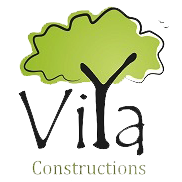

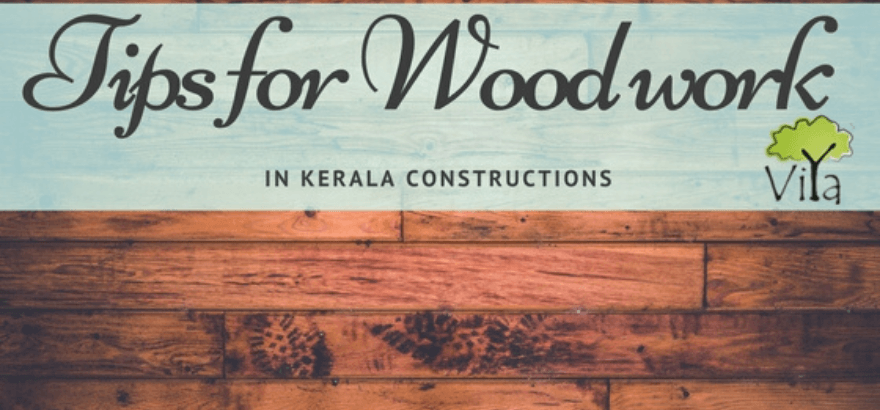

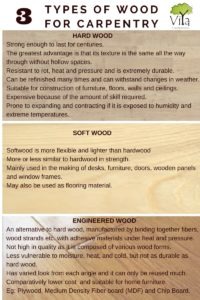
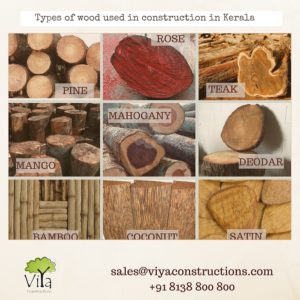
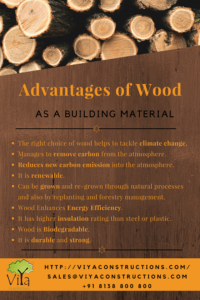

10 Basic Civil Construction Materials - Viya Constructions
[…] The nature of wood used determines the final look of the building. So, be sure to make the right choices of wood. In addition to making doors and windows, wood is used for making cupboards, panels, door/window […]